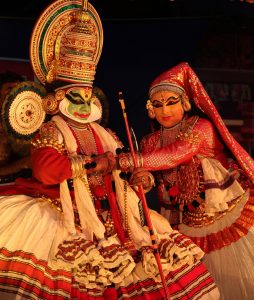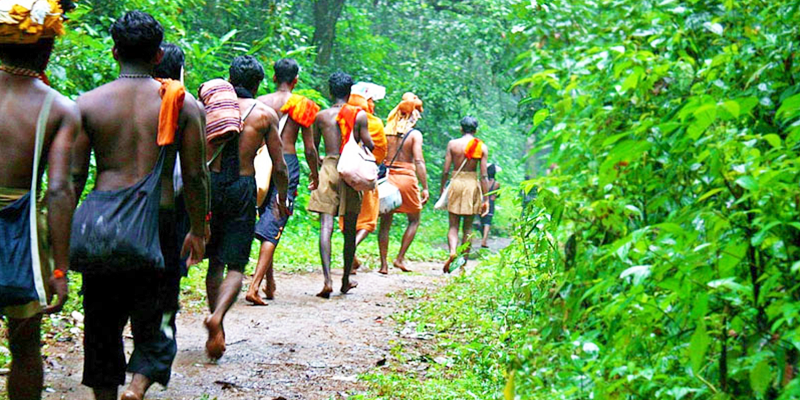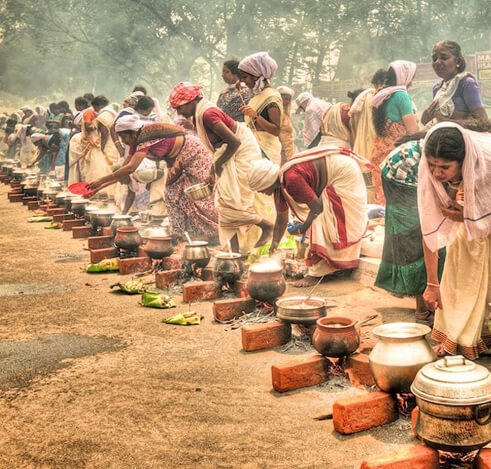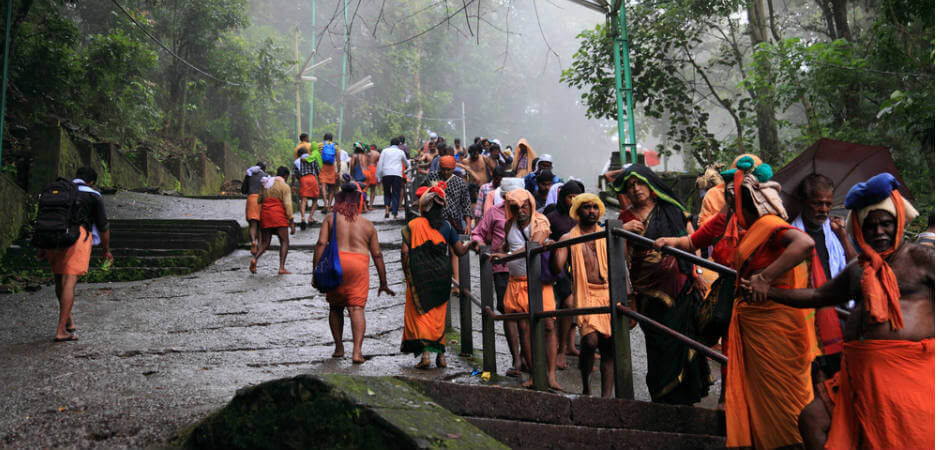One would wonder that when so much is being said and talked about in the Sabarimala case, what more could a sangha discuss? The news, opinions etc., give facts, legalities or opinions but do they question some of the basic notions of how we are talking about equality, discrimination, rituals from an inferior lens? The conversation brought out some of those important aspects, as shared below.
A: At the outset, I want to clarify that this discussion will not cover the legalities and judgement per se. There are many doing that already.
B: I agree, I want to understand how are we looking at women’s rights, how does tradition see a role of a woman and then if we compare it to modern times then what does it mean? I have been merely told that women are not allowed to go to Sabarimala during their reproductive years, but no one has ever told me the real or deeper reason why? I have seen so many rituals like the pUnal or thread ceremony which is exclusively for men and I ask why?
A: Let us try to understand some of these questions raised from a yogic lens, so that there is no forcing down of any opinion. The pUnal or thread ceremony stopped taking place for women in the 11th or 12th century and if you look at the sculptures of that period carefully you would find women with a pUnal too.
C: How did these changes take place?
D: There were many social shifts that happened over centuries and years through what was known as ‘sadas’ and it would be worthwhile to look at the process by which changes were made. The sadas included community leaders from all over the world (as they knew it), wise people and sages, who came together to take stock of the current social discords and realities. It was done once in 60 years, akin to the Jupiter cycle.
Like the Kumbh mela where we see a congregation of many sadhus, swamis, leaders from various sects, groups and akhAda who deeply ponder and dialogue the social dysfunctionalities in the world along with discussing steps can be taken to mitigate the dysfunctionalities. These dialogues also led to decisions such as how to teach common people the most meaningful ways of upholding the culture in changing times. Some historical accounts date the 11th century during the reign of Harshhavardhana when he called for one of these sabhas. It was not very successful and this is sometimes seen as the starting point of the decay of our society.
 A: The Shakyaar community of Kerala was supposed to have been created through this process. There were many children born to Nayars and other castes who held the music and theater traditions. So, there was a sabha called to discuss how to integrate them into the village community. They decided to allow these people to practice theater in Sanskrit. To me, such an exercise is very meaningful because until a consensus was reached the meeting would go on.
A: The Shakyaar community of Kerala was supposed to have been created through this process. There were many children born to Nayars and other castes who held the music and theater traditions. So, there was a sabha called to discuss how to integrate them into the village community. They decided to allow these people to practice theater in Sanskrit. To me, such an exercise is very meaningful because until a consensus was reached the meeting would go on.
D: The aim of these sabhas were not to give a moral stand and look at the community or reality from an external lens but a platform for nyAya, fairness. Different voices would be heard. Everyone took part in finding a solution and making sure that they were comfortable with the solution. It was very important to see that the solution ensured harmony and balance in the community.
E: In modern times, these would be called deep democracy dialogues. I wonder why can’t such a process be brought to discuss issues of temple entry?
A: It would be first fair to ask, “Who are the interested parties for this discussion?” The Sabarimala temple board is one, are there women who are genuinely interested to enter the temple and why so? Who are the other interested groups and what is their stake? Then they should dialogue this to find a meaningful solution. Though my first reaction to the Sabarimala case is that the people who questioned the entry, do not have a real stake in the tradition of the temple, or of the real women devotees.
E: I remember accompanying my Dad to Sabarimala almost 18 times and he has gone 40 odd times. I do understand the process of doing the pUjA, co-holding the pUjAs many times. It was never a one-man commitment to a vrdham because your entire family supported you in this journey. After the pilgrimage, the first thing we do is to give the prasAdam to the eldest in the family who is my Grandmother and then to my mother. I never think women were left out and felt discriminated.
This journey is also about reflecting on a man’s life so far. We had Guru swamy’s talk about some of their life’s stories and other men sharing some of their stories too. It was a ‘men’s sharing group’ without the typical alcohol and smokes that we find in modern urban centers.
C: But the people who filed the petition were women right?
A: They are not real Sabarimala bhaktas, I think they have been filing many petitions based on an idea of rights. Though I have not personally been to Sabarimala but my son has and even many of my friends talk about the process. But as an observer of the entire journey, I realized that there is a sense of equality that prevails.
B: How?

A: Everyone is dressed similarly, each one whether old, young, rich or poor is called Swami. The Guru Swami need not be the most educated person and he is merely leading the satsanga or the celebration.
E: A lot of people I know were indulging in alcohol and drugs, but during the 40 days of strictness they kept away from all such temptations. So, it was a great form of detoxification and it also helped them to discover a sense of vairagya. The entire walk to Sabarimala is no easy feat,it requires tremendous commitment and strength, a kind of inner strength that you tap into once you make a promise.
A: Yes, these are understood by the entire family because the men need to discover their boundaries and bring in a certain discipline.
B: But how is the family involved?
D: The decision to undertake this pilgrimage even for a first timer who is called kanni swami is taken by the entire family. The pilgrimage is taken on behalf of the entire family.
A: Going to a temple is not the same as visiting a mosque or a church. The dhyAna vastu i.e. the object on which I meditate impacts my psyche. The focus on the object and process is bound to impact you in a positive way. darshanam is not a process of me seeing the God but is one of opening myself out for the God to see me.
B: So that the energy enters me as well and awaken those inner latent energies.
D: Sabarimala is also a form of dhyAna vastu for men to discover their boundaries. Going to your family deity’s temple is not an isolated activity. You pray with a group of people and it is like a satsang.
C: It sounds like a community affair more than a private selfish affair.
E: True. Even in the Sabarimala pilgrimages, the group concentrates on Lord Ayyapa who is an idea of how a male should lead his life, what spiritual practices should one lead and how to be a better person and so on.
B: But the process of dhyAna is undertaken by both men and women. It is the same, so why the difference?
D: This concept of gender equality is a western liberal concept. Women undertake different practices and austerities to discover their boundaries and inner energies by specifically praying on certain deities.
 A: There is a festival in Kerala called Pongala in the Bhagvathy temple situated in the village of Attakul. Women line up on the roads leading up to the temple and cook Pongal with the fire that lights the main hearth in the garbha griha. It is a community offering of Pongal to Devi by women only.
A: There is a festival in Kerala called Pongala in the Bhagvathy temple situated in the village of Attakul. Women line up on the roads leading up to the temple and cook Pongal with the fire that lights the main hearth in the garbha griha. It is a community offering of Pongal to Devi by women only.
D: The Hindu and Buddhist thoughts on deities is very clear; the deity is just a representation of one’s own aspiration. One projects a very high and pure human attribute to an energy that is formless, thus I try and tap into this energy through a form that I hold with great dedication. This energy is what I need currently to help me.
C: Reminds me of theertasthalas where there are specific energies associated with certain temples based on the tapasyA of certain saints and rishis. Near Coimbatore there is a specific temple that people go to if they have lost something. A saint lost a certain valuable and so, he prayed to Shiva who restored the loss to him. Thus, this temple holds that energy. Of course, there is no way to measure these effects but if one goes with a certain mindset, then impact is bound to happen.
B: Reminds me of the temple visits we did with Sashikala who explained something very relevant. There is a certain energy of the siddha bhUmi i.e. the energies of the people who have established that temple. The years or centuries of shraddha, bhakti and the energy that has been given to the deity is enormous. One can feel it especially if one goes there with a specific intention. Different people have different intentions depending on where they are in life. Some people come to the temple to chit-chat and go or some people come with the family to pray or even the whole village goes there to celebrate. Your intention or prayer tuning into the energy of the temple or tIrthasthala determines the quality of impact.
A: There are certain temples which are very specific, more than other temples. There are people who understand the real meaning or energies of such temples and how powerful they can be. If people go there with a negative intention or spite, then it harms the natural energy of that space. The activists are going to Sabarimala questioning the energies and sanctity of the place.
E: I think there is a voice inside me that says that this is not looking at temples from the Hindu or community point of view.
D: This cannot be understood intellectually or sitting in a drawing room! Go to various temples and understand the energies and see how they speak to you.
C: There is also a very critical aspect of ishta devata. The vibrations of the devata triggers something inside you like an aspirational energy. Very often this trigger has to do with our own lacunae and gifts. The specific temples dedicated for these devata become critical. There is some energy in that deity or the way they conduct rituals etc., that is especially beneficial to the aspirant.
E: What do you mean by gifts?
B: Let me give you an example of the gifts from our temple visits. There were a few people in the group who could not connect to the Avinashi or Perur temples in Coimbatore, but could do so with some smaller ones which did not have a great architectural significance per se. However, these people felt a sweet sense of bhakti towards those temples just like the everyday life one leads. Sashikala, our vastu expert and teacher pointed out that this ability to find sweetness and beauty in mundane things is also a gift. She says that this awakens potentials within us that we are not conscious of. Isn’t that amazing?
C: One of difficulties I faced as a child was being told to do certain things and not to do certain things being a girl. Hence, there was a feeling of oppression or discrimination that lead to leaning towards the western concept of equality. The starting point to understand temples is that is not mere do’s and don’ts, but the underlying bhakti and energies associated with it.
A: Yes correct. The Kamakhya temple is said to be a very powerful one but I may not be drawn to it and someone else might be drawn to it and wants to go. If I do want to go there, I need to prepare myself for it to be able to receive the energies associated with it.
D: Powerful temples have restrictions rather than lesser ones.
B: I feel preparations is not only in terms of restrictions but also opening the indriyA and cleansing the mind.
A: Not to forget the abhyAsa one does along with the vairAgya. The abhyAsa is not merely getting up early in the morning, practicing celibacy and so on like the Sabarimala vratam recommends, but it is a sadhana or inner cleansing. abhyAsa and vairAgya are the yogic aspects which are very important. If you do not bring in this principle of abhyAsa-vairAgya then it is just a casual visit.
C: Can some temple visits backfire or have negative effects?
D: Yes, they can if you are not prepared. The Shani temple in Maharashtra I believe is known for some occult practices. So, the energies are difficult to manage and handle even for great astrologers. It may not suit me or work positively for me. If someone advises me about these things and I understand it with the framework we have talked about I would not go about harping about the fact that these advices are discriminatory.
A: Some of these ideas of liberalism may not even be relevant to us, Indians. The Indian thought and way of life always talks about balance and what will enhance my life or make it rAsatmik? If you are an Ayyappa bhakt, there are half a dozen Ayyappan temples in Kerala and elsewhere to visit. This one that has been singled out is meant for a specific type of confrontation of the male psyche. Let us try to understand it and respect it.
C: I also feel there is a separation in the people who make such decisions and the people who practice or have faith in these rituals.
A: This is why I was referring to the gathering of elders called the sadas which was practiced earlier. Are the women bhaktas of Ayyappa lining up and protesting it? I do not think so. They respect the tradition and would not unnecessarily provoke the community.
D: I see in this rights based litigation an echo of the idea of the “white man’s burden”. This was the justification used by the colonizer when he/she went about exploiting non-European people and lands. The litigants seem to be holding the moral agenda for an elitist, non-religious idea of India without understanding the Hindu lens through which to see these traditions. Impinging on other people’s traditions and cultures is very un-Indian
C: Trolling and shaming people who do not agree with your view is also un-Indian.
D: Exactly the way the colonizer was shaming you for being an Indian.
B: I am reminded of a newspaper article that mentions India as a rape capital of the world, which is ridiculous because there is enough statistics to prove that other countries including USA have similar or higher cases. Rapes are happening because there is a clash between the way one is brought up and the exposure to world that is emerging right now.
D: The shaming of the entire community who believes in the Sabarimala journey is being done which is very dangerous. I also feel these voices are being raised because there is an entire generation of people who have lost the connection to temples and communities.
A: True, because these petitioners are all outsiders and not an insider who feels responsible for taking forward this tradition and its spiritual energy.
E: It is impossible to argue from a legal logical sense because there is no energy meter that can measure these experiences.
B: Can I say that if a person whether a man or woman does not follow the 40-day vratham, they cannot go? Why bring in the fact that women cannot go?
A: I want to have a dialogue with women who want to go to Sabarimala and understand why they want to go and then the rituals come into the picture. This is the framework with which we should approach this issue.


 Anoop is a student of Yoga, an entrepreneur, a coach and a father of two young boys. He has led successful leadership stints in both the corporate and non-for-profit sectors. On encountering the country’s water/farmer crises at close quarters, he decided to pause and examine the impact various ‘isms’ – capitalism, colonialism, etc., were having on us as individuals, families, the society and the environment at large. This quest led him to formally engage with traditional Indic knowledge systems while also learning from the latest advances in science – about our physical and mental wellbeing, importance of body and mind work in healing trauma and the urgent need for a conscious rebuilding of family / work / social structures if we have to thrive individually and collectively. Insights, frameworks and processes gleaned from these on-going studies, an anchorage in his own personal practice and his wide-ranging experiences is what Anoop brings to facilitation/coaching spaces in Ritambhara and his various professional engagements.
Anoop is a student of Yoga, an entrepreneur, a coach and a father of two young boys. He has led successful leadership stints in both the corporate and non-for-profit sectors. On encountering the country’s water/farmer crises at close quarters, he decided to pause and examine the impact various ‘isms’ – capitalism, colonialism, etc., were having on us as individuals, families, the society and the environment at large. This quest led him to formally engage with traditional Indic knowledge systems while also learning from the latest advances in science – about our physical and mental wellbeing, importance of body and mind work in healing trauma and the urgent need for a conscious rebuilding of family / work / social structures if we have to thrive individually and collectively. Insights, frameworks and processes gleaned from these on-going studies, an anchorage in his own personal practice and his wide-ranging experiences is what Anoop brings to facilitation/coaching spaces in Ritambhara and his various professional engagements.
 Priya is a Yoga therapist in the Krishnamacharya tradition. She adapts Reiki & energy work, Vedic chanting, life coaching & Ayurvedic practices in her healing spaces. She is committed to nurturing collectives that have the praxis of Yoga at their heart.
Priya is a Yoga therapist in the Krishnamacharya tradition. She adapts Reiki & energy work, Vedic chanting, life coaching & Ayurvedic practices in her healing spaces. She is committed to nurturing collectives that have the praxis of Yoga at their heart. Anisha has been on an exploration to understand herself through yoga for the last 15years which led her to teaching yoga, yoga therapy and inner work through yoga.
Anisha has been on an exploration to understand herself through yoga for the last 15years which led her to teaching yoga, yoga therapy and inner work through yoga. Apoorva chanced upon Yoga in her early 20s. A spark was lit within and there was no turning back. Her exploration led her to the Krishnamacharya tradition more than a decade ago. Curious about human behaviour and what drives it, she was thrilled when her search ended (and also began) when she first came upon the Yoga Sutra, which illuminated a path towards answering many questions that had been held for a long time.
Apoorva chanced upon Yoga in her early 20s. A spark was lit within and there was no turning back. Her exploration led her to the Krishnamacharya tradition more than a decade ago. Curious about human behaviour and what drives it, she was thrilled when her search ended (and also began) when she first came upon the Yoga Sutra, which illuminated a path towards answering many questions that had been held for a long time. Anita is a yoga teacher and therapist in the tradition of Sri.T.Krishnamacarya and Sri T.K.V. Desikachar, a Reiki practitioner and a Life Coach. She is also the founder of Vishoka, a center for learning Indic and energy-based frameworks for living and healing. Her deep concern for human suffering and the problems of unsustainable living kept her on the path of seeking an integrated approach to looking at life, living, learning and healing.
Anita is a yoga teacher and therapist in the tradition of Sri.T.Krishnamacarya and Sri T.K.V. Desikachar, a Reiki practitioner and a Life Coach. She is also the founder of Vishoka, a center for learning Indic and energy-based frameworks for living and healing. Her deep concern for human suffering and the problems of unsustainable living kept her on the path of seeking an integrated approach to looking at life, living, learning and healing. Ankit is a seeker in the wisdom traditions of India. The core of his work includes creating dialogic spaces where people can look within and see the connection between their inner and outer lives. Inspired by the likes of Gandhi, Aurobindo, Vivekananda and Guru Gobind his experiments in service took him back to his roots in Punjab where he is creating a community-led model of higher education which is open, inclusive and accessible for all. Ritambhara for him is a space for engaging in a community which is committed to a DHramic life. He anchors his work of learning and leadership in the Antaranga Yoga Sadhana and the humanistic wisdom of Mahabharata.
Ankit is a seeker in the wisdom traditions of India. The core of his work includes creating dialogic spaces where people can look within and see the connection between their inner and outer lives. Inspired by the likes of Gandhi, Aurobindo, Vivekananda and Guru Gobind his experiments in service took him back to his roots in Punjab where he is creating a community-led model of higher education which is open, inclusive and accessible for all. Ritambhara for him is a space for engaging in a community which is committed to a DHramic life. He anchors his work of learning and leadership in the Antaranga Yoga Sadhana and the humanistic wisdom of Mahabharata.